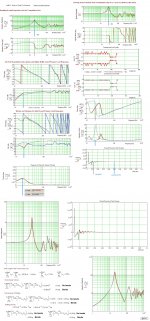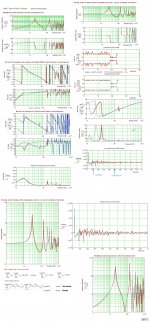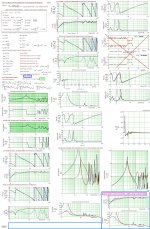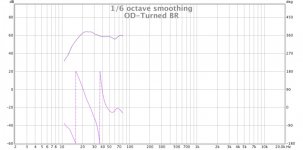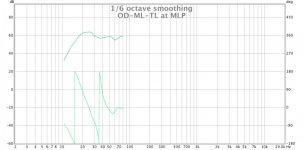Have you drilled the holes? How many of the inner partions can you reach from the driver mounting hole?
I hope we see a measurable difference, would emprically show mass loading is a real phenomenon and not just theoretical mamby pamby (precise engineering language could be substituted here).
I think two of these wil be great for the two channel rig, not sure how well they will work for HT as the don't dig below 20 Hz. The Labs 12s sound great in the temp sealed boxes I am using now, but they start rolling off to early (around 40 Hz). To counter, I have bumped up a bit with an LT via the miniDSP - but have to be careful with low end boost and cone excursion.
I don't get LT in practice. When modeling LT in winISP you have to reduce power significantly due to cone extension at the boosted frequencies, looking at before and after plots it seems it would be easier to use a shelf filter to bring down the higher frequencies instead of boosting lower. Overall the effect is almost identical if looking at max SPL at a given frequency below the LT boost due to reduced power handeling. Perhaps I am using the modeling incorrectly.
Sorry, I haven't fussed with it yet, I ended up in the middle of that bizarre may snow storm here just outside of Kansas City and wound up feeling ill this week, but I did get the wood for two new cabinets, so there should be some measurements soon. Just have to stop hacking and crooping long enough for it to be safe to use power tools :|
As far as LT, I think it's a toss up, either boosting low frequencies or cutting higher ones and then boosting everything back up to mate with mains.
I will most definitely be using these with HT, I'm going to have to confirm with measurements, but I think with the drivers I'm using, these are going almost as low as the tapped horns were pre-cataclysm, within a couple of cycles anyway, even with just one playing, they can still puff the room quite violently.
Andrea Zonn's "better be home soon" = happy fun times.
Hi All,
To answer the question of why I prefer the performance of an (OD) ML-TL versus a normal Ported BR is due to the port issues that always appear for a Driver with relative high xmax tuned low:
Over stuffing the Box and by adding Port stuffing are the only other measures that can be taken in order to keep the Port system reasonably small.
Take a serious look( zoom all the graphs) at the submitted pictures and you will find out why...
Note: The shown BR has a port diameter equal to the ML-TL.
The impact of folds in a quarter-wave enclosure are masked when stuffing is used thus can be ignored when simulating.
b
To answer the question of why I prefer the performance of an (OD) ML-TL versus a normal Ported BR is due to the port issues that always appear for a Driver with relative high xmax tuned low:
Over stuffing the Box and by adding Port stuffing are the only other measures that can be taken in order to keep the Port system reasonably small.
Take a serious look( zoom all the graphs) at the submitted pictures and you will find out why...
Note: The shown BR has a port diameter equal to the ML-TL.
The impact of folds in a quarter-wave enclosure are masked when stuffing is used thus can be ignored when simulating.
b
Attachments
Sorry, I haven't fussed with it yet, I ended up in the middle of that bizarre may snow storm here just outside of Kansas City and wound up feeling ill this week, but I did get the wood for two new cabinets, so there should be some measurements soon. Just have to stop hacking and crooping long enough for it to be safe to use power tools :|
As far as LT, I think it's a toss up, either boosting low frequencies or cutting higher ones and then boosting everything back up to mate with mains.
I will most definitely be using these with HT, I'm going to have to confirm with measurements, but I think with the drivers I'm using, these are going almost as low as the tapped horns were pre-cataclysm, within a couple of cycles anyway, even with just one playing, they can still puff the room quite violently.
Andrea Zonn's "better be home soon" = happy fun times.
Strange spring weather indeed, just got email from my brother in Topeka. Sorry to read you have been sick, I am on day 7 in a hospital in Bangkok. Always wanted to see Bangkok, to bad it by medical evacuation and ambulance ride. I get out and fly back to Phnom Penh tomorrow. Never thought I would be happy flying back to Phnom Penh.
Hi All,
To answer the question of why I prefer the performance of an (OD) ML-TL versus a normal Ported BR is due to the port issues that always appear for a Driver with relative high xmax tuned low:
Over stuffing the Box and by adding Port stuffing are the only other measures that can be taken in order to keep the Port system reasonably small.
Take a serious look( zoom all the graphs) at the submitted pictures and you will find out why...
Note: The shown BR has a port diameter equal to the ML-TL.
The impact of folds in a quarter-wave enclosure are masked when stuffing is used thus can be ignored when simulating.
b
b,
Thanks for the information, when I get back to my office computer I will print and study the attachements. This has really been an education for me!
Best,
Steve
Note: The shown BR has a port diameter equal to the ML-TL.
b
Does the BR have the exact same flare at each end of the port as the ODMLTL?
I'm sure making sure stuffing is correct, as well as performance at higher levels should be considerations, nevertheless, here's the result of my little experiment.
All I did was rip out the piece directly behind the driver, which I figure was enough to turn it into a fairly well braced BR enclosure.
Not sure if this answers any questions or even creates more.
*shrug*
All I did was rip out the piece directly behind the driver, which I figure was enough to turn it into a fairly well braced BR enclosure.
Not sure if this answers any questions or even creates more.
*shrug*
Attachments
To answer the question of why I prefer the performance of an (OD) ML-TL versus a normal Ported BR is due to the port issues ...........
Right, IME anytime a < 0.5 [~17 m/s] vent mach requires a long vent, it's better overall to take the cab and vent volume [net Vb] and morph it into an inverse tapered TL.
GM
Right, IME anytime a < 0.5 [~17 m/s] vent mach requires a long vent, it's better overall to take the cab and vent volume [net Vb] and morph it into an inverse tapered TL.
GM
Inverse tapered, ahh!
I wish I knew wtf I really want to build now, to be honest I'm glad my tapped horns got wet, that was too much of a trade off to get efficiency and output I really didn't need.
I was fairly convinced I wanted to build a good pair of these OD-ML-TL enclosures, but if it's better overall for something reverse tapered (are we talking about an OD-ML with a reverse taper or are we talking about T-TQWT?
Hmm, I see my response wasn’t quite ‘on track’ to bjorno’s…………… 
Regardless, nothing wrong with a MLTL, it's what I've mostly used, recommended over the decades since they work so well with traditional type drivers combined with the total effective system output impedance, but modern very low Vas and/or low Qt systems will spec TL length vents, so the inverse tapered TL or its tapped variant seems to me to be the obvious way to 'have my cake and eat it too' same as a TH is a morphed 6th order BP.
FWIW, I use different TL monikers for the purpose of clarity even though that technically, they are all just TLs and unfortunately are at odds with some of MJK’s monikers:
Constant [straight] taper = TL, ML-TL, etc.
Inverse taper = TQWT, ML-TQWT, etc.
Positive taper = horn, ML-horn, etc.
Where [ML = mass loaded] means a reflex vent is included to further lower system tuning.
Of course, there’s no clear cut break points WRT driver specs as to which is the best overall to use in every case, so it doesn’t hurt to try each one to see which one best overall suits the needs of the app.
As bjorno indicates, the constant tapered one covers most traditional apps and still many today and why I mostly recommend it or the ML-horn, especially since both are best overall [with a slight edge going to the latter] when a really wide BW is required with a medium Qt driver, but when there’s the need for some serious acoustical control down low, it’s hard to beat a TQWT and why I prefer it for ‘sub’ duty or getting a ‘choke hold’ on a high Qt driver.
The ‘stereo’ corner ‘subs’ I did back when other than for a few $$$ specialty R_T_R tapes, 32 Hz was pretty much the ‘bottom’ of even the best recordings, a ~16 Hz TQWT with a 15" low Qt, ~20 Hz Fs driver [or two ] at the floor and vent at the ceiling junction yielded a room enveloping, hear attack ‘fast’ bass that forced us to experiment extensively with turntable [TT] isolation.
] at the floor and vent at the ceiling junction yielded a room enveloping, hear attack ‘fast’ bass that forced us to experiment extensively with turntable [TT] isolation.
Positively wimpy by today’s HT’s LFE channel’s standards of course, but back when the average HIFI recording was ~ –10 dB/35 Hz, it was pretty thrilling, especially if you also had chest pounding mid-bass to go along with it.
GM
Regardless, nothing wrong with a MLTL, it's what I've mostly used, recommended over the decades since they work so well with traditional type drivers combined with the total effective system output impedance, but modern very low Vas and/or low Qt systems will spec TL length vents, so the inverse tapered TL or its tapped variant seems to me to be the obvious way to 'have my cake and eat it too' same as a TH is a morphed 6th order BP.
FWIW, I use different TL monikers for the purpose of clarity even though that technically, they are all just TLs and unfortunately are at odds with some of MJK’s monikers:
Constant [straight] taper = TL, ML-TL, etc.
Inverse taper = TQWT, ML-TQWT, etc.
Positive taper = horn, ML-horn, etc.
Where [ML = mass loaded] means a reflex vent is included to further lower system tuning.
Of course, there’s no clear cut break points WRT driver specs as to which is the best overall to use in every case, so it doesn’t hurt to try each one to see which one best overall suits the needs of the app.
As bjorno indicates, the constant tapered one covers most traditional apps and still many today and why I mostly recommend it or the ML-horn, especially since both are best overall [with a slight edge going to the latter] when a really wide BW is required with a medium Qt driver, but when there’s the need for some serious acoustical control down low, it’s hard to beat a TQWT and why I prefer it for ‘sub’ duty or getting a ‘choke hold’ on a high Qt driver.
The ‘stereo’ corner ‘subs’ I did back when other than for a few $$$ specialty R_T_R tapes, 32 Hz was pretty much the ‘bottom’ of even the best recordings, a ~16 Hz TQWT with a 15" low Qt, ~20 Hz Fs driver [or two
Positively wimpy by today’s HT’s LFE channel’s standards of course, but back when the average HIFI recording was ~ –10 dB/35 Hz, it was pretty thrilling, especially if you also had chest pounding mid-bass to go along with it.
GM
...when a really wide BW is required with a medium Qt driver, but when there’s the need for some serious acoustical control down low, it’s hard to beat a TQWT and why I prefer it for ‘sub’ duty or getting a ‘choke hold’ on a high Qt driver.
The ‘stereo’ corner ‘subs’ I did back when other than for a few $$$ specialty R_T_R tapes, 32 Hz was pretty much the ‘bottom’ of even the best recordings, a ~16 Hz TQWT with a 15" low Qt, ~20 Hz Fs driver [or two ] at the floor and vent at the ceiling junction yielded a room enveloping, hear attack ‘fast’ bass that forced us to experiment extensively with turntable [TT] isolation.
So, not a tapped tqwt then, you're essentially talking about a tube with a driver at one end that inverse tapers to a slot port at the other? Or am I misunderstanding your description?
I'm sure making sure stuffing is correct, as well as performance at higher levels should be considerations, nevertheless, here's the result of my little experiment.
All I did was rip out the piece directly behind the driver, which I figure was enough to turn it into a fairly well braced BR enclosure.
Not sure if this answers any questions or even creates more.
*shrug*
Looks like the BR has a better frequency response and is an easier build than the ODMLTL. I say go TTQWT! 7 boards minimum for a single fold.
Last edited:
And I like my T-TQWT enclosures for the old Peerless drivers I have, I'm just terrible enough with Hornresp to come up with something terrible if I were to try to model one with these drivers.Looks like the BR has a better frequency response and is an easier build than the ODMLTL. I say go TTQWT! 7 boards minimum for a single fold.
Edit: I do think however that if I use stuffing properly (my test box was stuffed rather carelessly) the response will be a little nicer.
Last edited:
After tinkering with some T-TQWT options that I "borrowed" from another thread where Epic 12s are involved, the overall bandwidth and efficiency seems to be more on track with the OD-ML-TL.
Once I can get my nose to stop running, I'll go make some sawdust on two of these, after all, I was fairly pleased with the single one that was hastily assembled with not-so-careful measurements.
I'm also assuming that cutting to the nearest 8th inch is acceptable, some of these measurements call for .00x of an inch and I'm afraid I don't have a micrometer
Once I can get my nose to stop running, I'll go make some sawdust on two of these, after all, I was fairly pleased with the single one that was hastily assembled with not-so-careful measurements.
I'm also assuming that cutting to the nearest 8th inch is acceptable, some of these measurements call for .00x of an inch and I'm afraid I don't have a micrometer
So, not a tapped tqwt then, you're essentially talking about a tube with a driver at one end that inverse tapers to a slot port at the other? Or am I misunderstanding your description?
Nope, the thread title is about non tapped TLs, so responded in kind.
Yes, the closed end is large, tapering down to whatever size the vent you want the vent to be. Normally it's a single fold with the driver placed either at the closed end or offset a bit.
GM
Hi DrDyna,
Take a look at the drawing in Post #15 here:
http://www.diyaudio.com/forums/subwoofers/235322-subwoofer-driver-choices-diy-sub-2.html
It's derived from my Hornresp simulation in Post #8. Also, see bjorno's nice work-ups in Posts #12 and #19 in that thread. I think that's what you're looking for. You'll have to adapt the general form to your driver/Hornresp model.
As to the decimals in the measurements: 1/64th inch = 0.015625", 1/16th = .0625, a CAD program will give you something that cannot be achieved in plywood. Just use your best judgement, you can always use Hornresp as a guide to tell you which dimensions are critical.
Regards,
Take a look at the drawing in Post #15 here:
http://www.diyaudio.com/forums/subwoofers/235322-subwoofer-driver-choices-diy-sub-2.html
It's derived from my Hornresp simulation in Post #8. Also, see bjorno's nice work-ups in Posts #12 and #19 in that thread. I think that's what you're looking for. You'll have to adapt the general form to your driver/Hornresp model.
As to the decimals in the measurements: 1/64th inch = 0.015625", 1/16th = .0625, a CAD program will give you something that cannot be achieved in plywood. Just use your best judgement, you can always use Hornresp as a guide to tell you which dimensions are critical.
Regards,
After tinkering with some T-TQWT options that I "borrowed" from another thread where Epic 12s are involved, the overall bandwidth and efficiency seems to be more on track with the OD-ML-TL.
Once I can get my nose to stop running, I'll go make some sawdust on two of these, after all, I was fairly pleased with the single one that was hastily assembled with not-so-careful measurements.
I'm also assuming that cutting to the nearest 8th inch is acceptable, some of these measurements call for .00x of an inch and I'm afraid I don't have a micrometer
DrDyna, I am very interested in what you discover. If you don't post here please let me know where you post. Originally this thread was for a T-TQWT design.
Nope, the thread title is about non tapped TLs, so responded in kind.
Yes, the closed end is large, tapering down to whatever size the vent you want the vent to be. Normally it's a single fold with the driver placed either at the closed end or offset a bit.
GM
GM, I am open to all ideas that maximize the potential of the LAB12 drivers for HT. Luckily DrDyna's TC Sounds Epic 12's model almost the same as the LAB12's, ecept for more Xmax resulting in greater SPL. I am stuck away from tools for several more months, this thread has had a way of evolving over time.
- Status
- This old topic is closed. If you want to reopen this topic, contact a moderator using the "Report Post" button.
- Home
- Loudspeakers
- Subwoofers
- Lab 12 Based Offset Driver - Mass Loaded - Transmission Line (OD-ML-TL) Design by Bj
